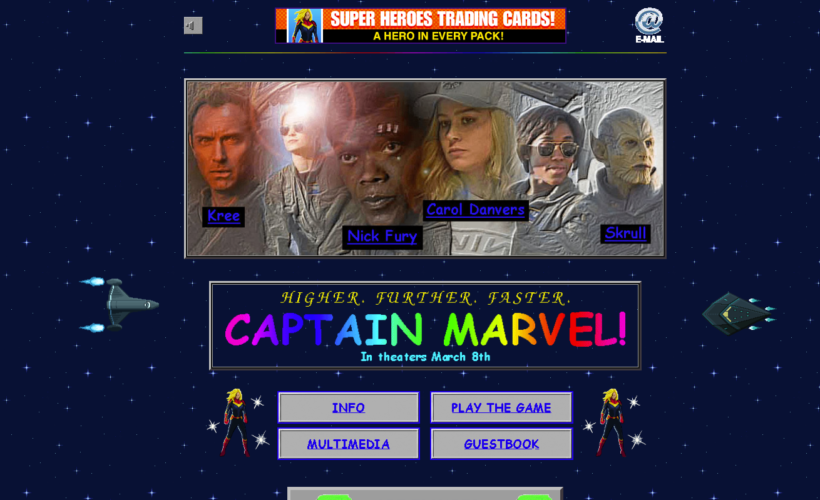Try to think back to a time when the internet wasn’t a toxic mix of rage and false equivalence. Trick question! It’s always been. But for a few glorious years in the 1990s, it was also glittery and welcoming and amateurish and wonderful and absurd. It was the age of Geocities, and an era Marvel has played pitch-perfect homage to with its recently launched Captain Marvel website.
The latest cinematic superhero caper comes out on March 8, but it takes place in 1995, a fact that its first trailer seized on perhaps too tightly. (Blockbuster Video! Get it?) But the movie’s promotional site doesn’t just wink at the Matchbox Twenty era. It fully inhabits it. Site counter? Check. HTML frames? Check. A discordant yet earnest mix of font sizes, serifs, and colors? Check them all, friends.
There’s so much more, of course; the Captain Marvel site embraces that era’s maximalist ways. The tools were relatively new, the temptation to use them all impossible to resist. It houses most of the functions of a traditional promotional site; you can watch the trailer and flip through promotional frames. But it does so through a ’90s patina so thick you can practically smell the Mr. Sketch Scented Markers. (There’s also a requisite Stan Lee Easter egg that’s more fun to find on your own.)
Fortunately, you don’t need to take anyone’s word for how closely it hews to sites of that era. Geocities itself disappeared from the internet proper in 2009 but has lived on thanks to archival efforts. There’s even a search engine for old sites, although many of them are now broken in various ways. Or better yet, look to the shockingly well-preserved site for another movie, Space Jam, an internet time capsule that has famously defied the cruelties of time.
“I give them a huge amount of credit,” says Dara-Lynn Weiss, one of the producers who built the Space Jam site in 1996, of the Captain Marvel throwback. “It is very well done. It is funny, and it is accurate, and it is authentic and not overplaying itself. It really is perfect.”
Marvel’s 2019 tribute to the internet of yesteryear resembles an enthusiast’s page more than what studios produced, even back then. “We never made anything this ugly,” Weiss says. “Clicking through the pictures took me back. The production photos. The flashing text, which we certainly did. The counter was always a little beneath us, but the counter is hilarious.”
Even the way Marvel built the site appears to have been at least approximately true to the era. The company declined to make the team available for interviews, but Marvel Entertainment director of software engineering Lori Lomberg shared on Twitter that they built it using FrontPage, an HTML editor from the late ’90s into the early aughts, and hosted it on Angelfire, a service that launched in 1996 and, surprise, still exists.
The Captain Marvel site does take some liberties. It weighs in at 382 kilobytes—well over 100 times greater than the Space Jam homepage, and a bear to download given the cutting edge of modem technology at the time. (In fairness, it’s still tiny next to, say, WIRED.com, which sat at 4.7 megabytes in a recent spot check.) The counter doesn’t actually count. The guest book doesn’t actually take sign-ins. And the assets the site houses—the promotional stills, the trailer—retain all their 21st-century sheen.
As far as gambits go, affixing a website to the same era that the movie it promotes takes place seems like a safe bet. “Nostalgia is generally hugely effective,” says Marlene Towns, a professor of marketing at Georgetown University’s McDonough School of Business. “It seems like no matter what the generation, no matter what the time period, people are always longing for some previous era that was a kinder, gentler time.”
That may be felt even more acutely on the internet, especially given that for most people, 1995 represents a sort of prehistory. Only 14 percent of the US went online from work, school, or home that year, according to a contemporaneous Pew Research study.
“It is very specific, and it is going to appeal to a very particular segment,” Towns says. “But it also crosses generations still. For younger users it’s novel, and it’s kind of quaint, like, isn’t that cute, look at how the old people used to do it.”
Which underscores another major difference between sites like Captain Marvel and the Space Jam pioneers: People will actually see the former.
“We felt like the neglected kid brother that no one cared about. We would have to beg for assets to put on these sites. If you look at Space Jam, there’s not much there. No one cared,” Weiss says. “My boss, Don Buckley—genius, visionary, wonderful guy—fought and fought to get URLs put on the poster, and they were tiny. Obviously there was an audience online, but it was not a major driver for movie awareness.”
Meanwhile, the Captain Marvel site has notched over 100,000 engagements on Facebook in just a few days, according to data from analytics company Buzzsumo. It’s the kind of reach Geocities could never have imagined in its heyday, that mythical simpler time, before Facebook existed at all.
More Great WIRED Stories
- There’s still so much we need to learn about weed—fast
- TV’s second chance for trans representation—done right
- Messenger lets you unsend now. Why don’t all apps?
- What it takes to pull off the country’s first online census
- With its new 911, Porsche improves the unimprovable
- ? Looking for the latest gadgets? Check out our latest buying guides and best deals all year round
- ? Want more? Sign up for our daily newsletter and never miss our latest and greatest stories
Source:WIRED










